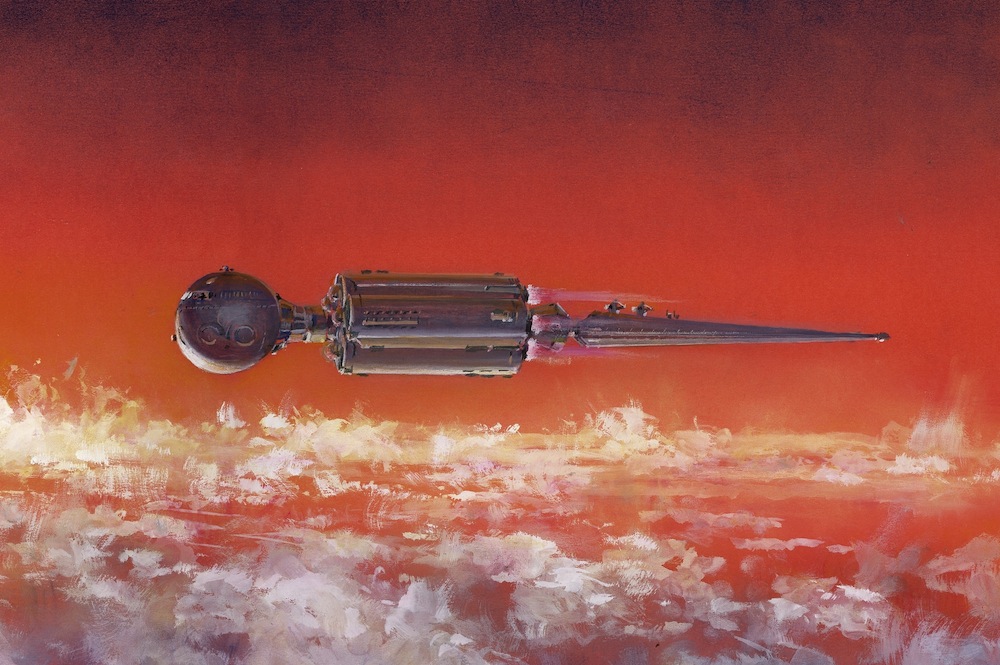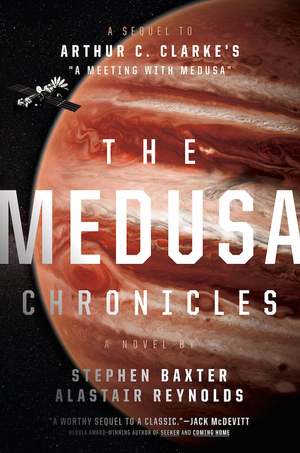

Discovery, the spacecraft in Arthur C. Clarke’s “2001: A Space Odyssey,” drawn in a concept painting for Stanley Kubrick’s “2001” movie.
Credit: Copyright © 2014 Turner Entertainment Co. 2001: A Space Odyssey and all related characters and elements are trademarks of and © Turner Entertainment Co. (s14)
Science-fiction author Stephen Baxter co-wrote the “A Time Odyssey” series of books with Arthur C. Clarke, author of “2001: A Space Odyssey.” More recently, Baxter teamed up with author Alastair Reynolds to write “The Medusa Chronicles” (Saga Press, 2016) which expands on a short story Clarke wrote in 1971.
Baxter was inspired to write this piece for Space.com after he drew heavily from Clarke’s spaceship designs for that work; in the pages of fiction and in the real world, Clarke “was a postwar visionary regarding possible spacecraft designs and purposes,” Baxter told Space.com.
It’s the year 2099. What do spaceships look like? The great science fiction author Arthur C. Clarke had some pretty visionary — yet surprisingly realistic — ideas.

“The Medusa Chronicles” (Saga Press, 2016), by Stephen Baxter and Alastair Reynolds, expands on a short story by Arthur C. Clarke.
Credit: Saga Press
“The Medusa Chronicles ,” a book I co-authored with Alastair Reynolds, is a sequel to Clarke’s 1971 novella “A Meeting with Medusa,” a saga of the exploration of space (and, specifically, of Jupiter). In the course of drafting the book, we had a lot of fun with speculative spacecraft designs, drawing heavily on Clarke’s wider work.
Thus, in the year 2099, our hero Howard Falcon flies “Discovery”-class, interplanetary, fusion-propelled ships — a nod to Clarke’s “2001” series (1968 onward). And by 2284, he uses more advanced “Goliath”-class ships — a reference to “The Hammer of God” (1993), as well as an homage to later entries in the “2001” series. [Gallery: Visions of Interstellar Starship Travel ]
Clarke was a real-world spaceflight visionary, but he never forgot his boyhood science-fiction dreams. And that background is reflected in his fiction.
Born in 1917, Clarke had grown up with gaudy and mostly impractical pulp-era visions of spaceflight. But as a young man, working with early space-advocacy bodies such as the British Interplanetary Society (BIS), he contributed to speculative but realistic designs of craft capable of interplanetary travel, as documented in his highly readable nonfiction survey “Interplanetary Flight” (1950) as well as in his fiction.
Thus, Clarke’s 1951 novel “The Sands of Mars” featured what may have been the first reasonably realistic fictional depiction of a spacecraft powered by a fusion rocket. Earlier writers, such as Olaf Stapledon, had vaguely described spaceflight using nuclear energy, but Clarke gave precise numbers for his spaceliner Ares, which he described as flying in the 1990s, capable of a 100-day trip to Mars.
Ares is a luxurious passenger liner that includes a dining hall measuring about 400 feet (120 meters) across. The design is a dumbbell — similar to the later Discovery of “2001” (1968) . There is a main sphere with a radius of about 200 feet (60 m) containing passenger cabins and a lower hemisphere that’s “almost entirely fuel.” A 330-foot (100 m) strut connects the main sphere to the smaller engine sphere. Ares is an “atomic rocket,” and specifically fusion-driven : “The forces that powered the stars themselves were being unleashed,” clarke wrote. And the dumbbell design is logical, with the inhabited sections positioned as far as possible from the leaked radiation of the engine.

Stephen Baxter (right) with Alastair Reynolds, co-author of “The Medusa Chronicles.”
Credit: Saga Press
Where Clarke gives specific numbers, they are sensible. To drive the ship out of high Earth orbit, the engines of Ares burn for 11 hours at 5 percent the acceleration of Earth’s gravity, and then Ares coasts for 100 days to Mars and decelerates. You can work out that after such a journey, 1.1 astronomical units (AU) would have been traveled — a reasonable distance for an Earth-Mars flight. (One AU is the average distance from the Earth to the sun — 93 million miles, or 150 million kilometers.) Clarke doesn’t give a specific mass breakdown, but a reasonable estimate is that the engine’s exhaust velocity would be several hundred kilometers per second. That’s well within the anticipated performance of fusion engines; the uncrewed starship of the BIS’ Daedalus design had an exhaust velocity of 9,000 km/s (5,600 miles per second). Clarke’s spacecraft always had reasonable and consistent designs — a lesson for any budding hard-sci-fi writer.
But, with time, those designs evolved.
While we worked on “Medusa,” I took the chance to re-read the four books of the Odyssey series: “2001: A Space Odyssey” (1968); “2010: Odyssey Two” (1982); “2061: Odyssey Three” (1987); and “3001: The Final Odyssey” (1997). And I was very struck by how Clarke’s visions of spacecraft developed over the course of those books.
Although the movie “2001” was first screened the same year Apollo 8 circled the moon , its vision was a sort of summary of older dreams of spaceflight — including Clarke’s own. The space clippers and great rotating space wheels were straight out of a blueprint that German aerospace engineer Wernher von Braun had been developing for NASA since the 1950s, while the beautiful, elegant Discovery is a classic Clarke dumbbell shape.
But by the time “2010” was published in 1982, the last Apollo mission was already 10 years in the past, and the space shuttle had just begun flying; we had learned what space is really like. In the story, a new spacecraft, called Leonov, goes to Jupiter to retrieve the lost Discovery. The contrast between the old and new spacecraft is very striking — visually so in the movie. Leonov is an expression of the reality of spaceflight as it had been experienced: It is cramped, uncomfortable, squat and ugly — and there’s certainly no gravity-inducing carousel. When the two spacecraft dock, it’s a collision of post-Apollo reality with pre-Apollo dreams, as if two universes were overlapping. [Arthur C. Clarke: Luminaries Pay Tribute ]
But by “3001,” thanks to the advanced-physics “inertial drive,” more extravagant spacecraft designs became possible. With a craft that can travel at several thousand kilometers per second, even the very sparse interplanetary dust is a significant hazard, and streamlining and shielding are necessary. And so the old pulp-magazine fantasies of Clarke’s boyhood are back, as Clarke says explicitly through a character in the novel. As reincarnated “2001” astronaut Frank Poole puts it, “Do you know what Goliath reminds me of? … When I was a boy, I came across a whole pile of old science-fiction magazines that my Uncle George had abandoned — ‘pulps’, they were called … They had wonderful garish covers, showing strange planets and monsters — and of course, spaceships! As I grew older, I realised how ridiculous those spaceships were. They were usually rocket-driven — but there was never any sign of propellant tanks! Some of them had rows of windows from stem to stern, just like ocean liners. There was one favourite of mine with a huge glass dome — a space-going conservatory … Well, those old artists had the last laugh … Goliath looks more like their dreams than the flying fuel-tanks we used to launch from the Cape.”
Though the “2001” books were obviously written within the span of a single lifetime, they date from different epochs. There is an immense gulf especially between the first two books. As Clarke noted in his foreword to “2010,” “2001” was written in an age that now lies beyond one of the Great Divides in human history; we are sundered from it forever by the moment when Neil Armstrong set foot upon the Moon [in 1969].” But Clarke’s visionary work — as refined and updated by such studies as the BIS’ current fusion-ship study Project Icarus — still stands as a bridge between the fantastic dreams of the past and the practicalities of the future.
Follow all of the Expert Voices issues and debates — and become part of the discussion — on Facebook , Twitter and Google+ . The views expressed are those of the author and do not necessarily reflect the views of the publisher. This article was originally published on Space.com .
Comments are closed.